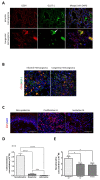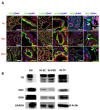Is Infantile Hemangioma a Neuroendocrine Tumor?
- PMID: 35563552
- PMCID: PMC9104933
- DOI: 10.3390/ijms23095140
Is Infantile Hemangioma a Neuroendocrine Tumor?
Abstract
Infantile hemangioma (IH) is the most common infantile tumor, affecting 5-10% of newborns. Propranolol, a nonselective β-adrenergic receptor (ADRB) antagonist, is currently the first-line treatment for severe IH; however, both its mechanism of action and its main cellular target remain poorly understood. Since betablockers can antagonize the effect of natural ADRB agonists, we postulated that the catecholamine produced in situ in IH may have a role in the propranolol response. By quantifying catecholamines in the IH tissues, we found a higher amount of noradrenaline (NA) in untreated proliferative IHs than in involuted IHs or propranolol-treated IHs. We further found that the first three enzymes of the catecholamine biosynthesis pathway are expressed by IH cells and that their levels are reduced in propranolol-treated tumors. To study the role of NA in the pathophysiology of IH and its response to propranolol, we performed an in vitro angiogenesis assay in which IH-derived endothelial cells, pericytes and/or telocytes were incorporated. The results showed that the total tube formation is sensitive to propranolol only when exogenous NA is added in the three-cell model. We conclude that the IH's sensitivity to propranolol depends on crosstalk between the endothelial cells, pericytes and telocytes in the context of a high local amount of local NA.
Keywords: adrenergic; betablocker; catecholamines; hemangioma; propranolol; telocytes.
Conflict of interest statement
A patent has been granted for the use of beta-blockers in infantile capillary hemangiomas with A.T. and C.L.L. as the inventors and Bordeaux University and Bordeaux University Hospital as owners of the patent. None of the authors has any other financial interest related to this work.
Figures





Similar articles
-
Critical role of Aquaporin-1 and telocytes in infantile hemangioma response to propranolol beta blockade.Proc Natl Acad Sci U S A. 2021 Feb 16;118(7):e2018690118. doi: 10.1073/pnas.2018690118. Proc Natl Acad Sci U S A. 2021. PMID: 33558238 Free PMC article.
-
Propranolol induces regression of hemangioma cells via the down-regulation of the PI3K/Akt/eNOS/VEGF pathway.Pediatr Blood Cancer. 2015 Aug;62(8):1414-20. doi: 10.1002/pbc.25453. Epub 2015 Mar 1. Pediatr Blood Cancer. 2015. PMID: 25728347
-
Propranolol Targets Hemangioma Stem Cells via cAMP and Mitogen-Activated Protein Kinase Regulation.Stem Cells Transl Med. 2016 Jan;5(1):45-55. doi: 10.5966/sctm.2015-0076. Epub 2015 Nov 16. Stem Cells Transl Med. 2016. PMID: 26574555 Free PMC article.
-
The use of propranolol in the treatment of infantile haemangiomas: an update on potential mechanisms of action.Br J Dermatol. 2015 Jan;172(1):24-32. doi: 10.1111/bjd.13388. Epub 2014 Dec 17. Br J Dermatol. 2015. PMID: 25196392 Review.
-
Infantile hemangioma-mechanism(s) of drug action on a vascular tumor.Cold Spring Harb Perspect Med. 2011 Sep;1(1):a006460. doi: 10.1101/cshperspect.a006460. Cold Spring Harb Perspect Med. 2011. PMID: 22229118 Free PMC article. Review.
Cited by
-
Propranolol: a new pharmacologic approach to counter retinopathy of prematurity progression.Front Pediatr. 2024 Jan 16;12:1322783. doi: 10.3389/fped.2024.1322783. eCollection 2024. Front Pediatr. 2024. PMID: 38292211 Free PMC article. Review.
-
Infantile hemangioma models: is the needle in a haystack?J Transl Med. 2023 May 6;21(1):308. doi: 10.1186/s12967-023-04144-0. J Transl Med. 2023. PMID: 37149592 Free PMC article. Review.
-
Impact of congenital heart disease on clinical outcomes of oral propranolol therapy for Infantile hemangiomas: a propensity score-matched analysis.BMC Pediatr. 2025 May 3;25(1):354. doi: 10.1186/s12887-025-05707-4. BMC Pediatr. 2025. PMID: 40319231 Free PMC article.
References
-
- Haggstrom A.N., Drolet B.A., Baselga E., Chamlin S.L., Garzon M.C., Horii K.A., Lucky A.W., Mancini A.J., Metry D.W., Newell B., et al. Prospective study of infantile hemangiomas: Clinical characteristics predicting complications and treatment. Pediatrics. 2006;118:882–887. doi: 10.1542/peds.2006-0413. - DOI - PubMed
-
- Léauté-Labrèze C., Hoeger P., Mazereeuw-Hautier J., Guibaud L., Baselga E., Posiunas G., Phillips R.J., Caceres H., Lopez Gutierrez J.C., Ballona R., et al. A Randomized, Controlled Trial of Oral Propranolol in Infantile Hemangioma. N. Engl. J. Med. 2015;372:735–746. doi: 10.1056/NEJMoa1404710. - DOI - PubMed
MeSH terms
Substances
Grants and funding
LinkOut - more resources
Full Text Sources
Medical

